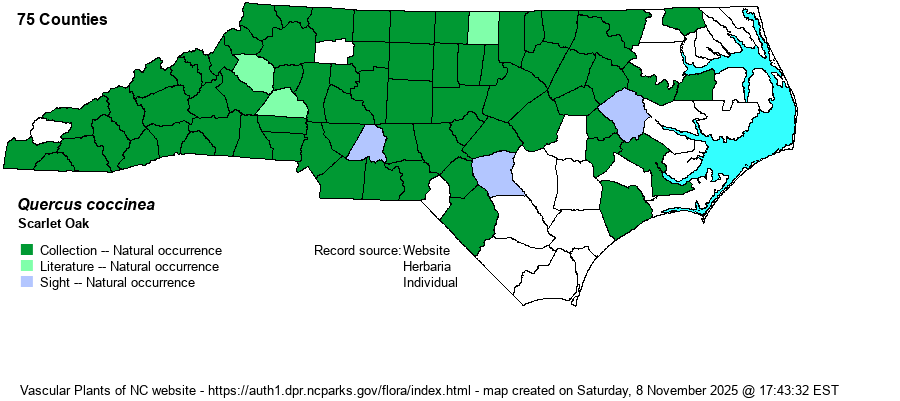| Author | Muenchhausen | |
| Distribution | Throughout the Mountains and Piedmont; scattered over much of the western half of the Coastal Plain. Apparently absent from much of the eastern third of the Coastal Plain.
This is an Eastern species ranging from ME and southern WI south to southern AL and MS. Absent from FL.
| |
| Abundance | Generally rather common to common eastward to the northwestern Coastal Plain, though can be somewhat local or infrequent in a few areas. Mostly infrequent or uncommon in the northwestern Coastal Plain, as well as in the Sandhills; rare in the eastern parts of that province. Not nearly as numerous as White Oak (Q. alba) in our upland forests of the mountains and Piedmont, but it can be quite common in some montane dry forests at middle elevations. | |
| Habitat | This is a species of upland forests, mostly where dry or somewhat rocky (or both). It clearly favors acidic soils, which are common in the state. In many areas, it is found mostly on the tops of ridges or on monadnocks, much less so on side slopes, ravines, and xeric flats. It the Coastal Plain, where topography is rather subdued, it grows in the more xeric, rocky areas (but not in deep sands). |
| Phenology | Flowers in April, and fruits from September to November of the second year. Note that members of the “red oak group”, which typically have bristles on the tips of leaves and leaf lobes, have acorns that require about 1 1/2 years to mature, and thus “the second year” is needed when describing the fruiting period. | |
| Identification | Though familiar to all who spend time outdoors, it can easily be confused with several other “red oak group” species. It is a medium to rather large deciduous tree, ranging to about 80-85 feet tall on average. The medium-sized leaves have deep sinuses, yielding 7-9 strong/deep lobes with bristle tips. They are rather thin in texture, and very similar to those of Shumard Oak (Q. shumardii), though Scarlet tends to also be shiny green below on the leaf surface. Shumard has somewhat darker green leaves above, and it grows essentially only on rich bottomlands, natural levees, and rich lower slopes, typically on high pH soils. If the acorns can be seen, Shumard has large acorns with a flat cup, which covers barely 1/3 or less of the acorns; Scarlet has a semi-rounded cup that covers half of the much smaller acorn. Black Oak (Q. velutina), which often grows with Scarlet, usually has rather thick leaves with a shiner upper surface, and the trunk is dark -– blackish, whereas Scarlet and Shumard have gray bark. In fall, Scarlet Oak does indeed have leaves that turn a deep wine-colored red (not really scarlet). | |
| Taxonomic Comments | Few references show varieties for this species, though NatureServe does. Thankfully, only the nominate one -– Q. coccinea var. coccinea, occurs in NC.
| |
| Other Common Name(s) | None | |
| State Rank | S5 | |
| Global Rank | G5 | |
| State Status | | |
| US Status | | |
| USACE-agcp | | |
| USACE-emp | | |

